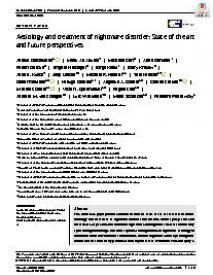Aetiology and treatment of nightmare disorder : State of the art and future perspectives
This consensus paper provides an overview of the state of the art in research on the aetiology and treatment of nightmare disorder and outlines further perspectives on these issues. It presents a definition of nightmares and nightmare disorder followed by epidemiological findings, and then explains existing models of nightmare aetiology in traumatized and non‐traumatized individuals.
Chronic nightmares develop through the interaction of elevated hyperarousal and impaired fear extinction. This interplay is assumed to be facilitated by trait affect distress elicited by traumatic experiences, early childhood adversity and trait susceptibility, as well as by elevated thought suppression and potentially sleep‐disordered breathing. Accordingly, different treatment options for nightmares focus on their meaning, on the chronic repetition of the nightmare or on maladaptive beliefs.
Clinically, knowledge of healthcare providers about nightmare disorder and the delivery of evidence‐based interventions in the healthcare system is discussed. Based on these findings, we highlight some future perspectives and potential further developments of nightmare treatments and research into nightmare aetiology.
In: Journal of Sleep Research, ISSN 0962-1105 ; eISSN 1365-2869 | e12820
https://doi.org/10.1111/jsr.12820
Early View Online Version of Record before inclusion in an issue e12820 ; 29 January 2019


